DPI Shark Meshing 2018/19 Performance Report: Nets Catching Turtles Instead Of Sharks + Alternatives Being Tested
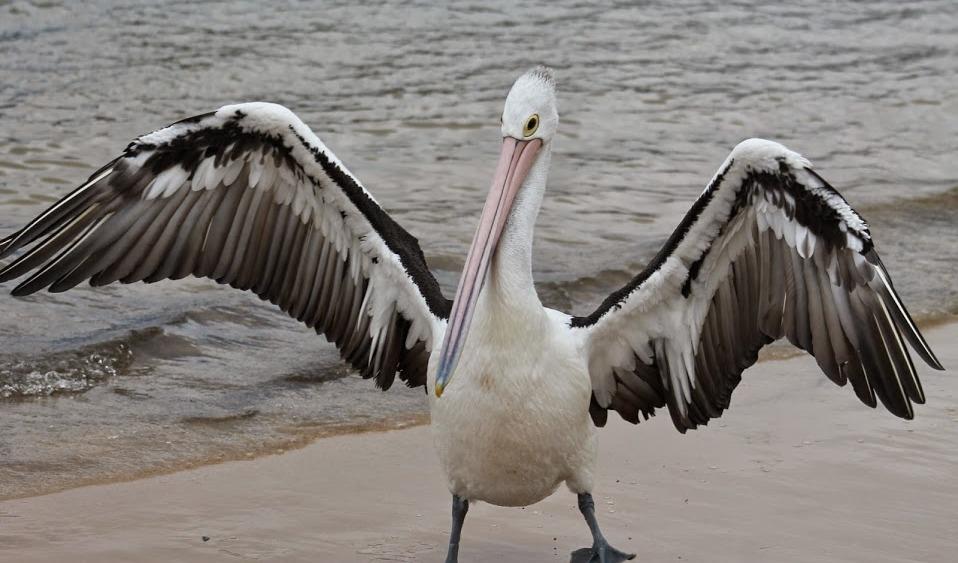
The records that 238 of those 395 died before they could be released. Among them are species that are endangered or have 'protected' status and through the SMP's report tripped 'trigger points'; -
2018-19: The trigger point for the objective of ‘Minimise the impact on non-target species and to ensure that the SMP does not jeopardise the survival or conservation status of threatened species’ was tripped for three species during 2018/19 following the entanglement of six Loggerhead Turtles, four Leatherback Sea Turtles, four Hawksbill Turtles, and eighty-seven Smooth Hammerheads.
Of those four Leatherback Sea Turtles, two died in nets off our beaches at Palm Beach and one was released from the nets at Newport. Readers may recall a report from March this year in which the great work of Newport SLSC Life Savers in disentangling an adult Leatherback stopped it from dying.
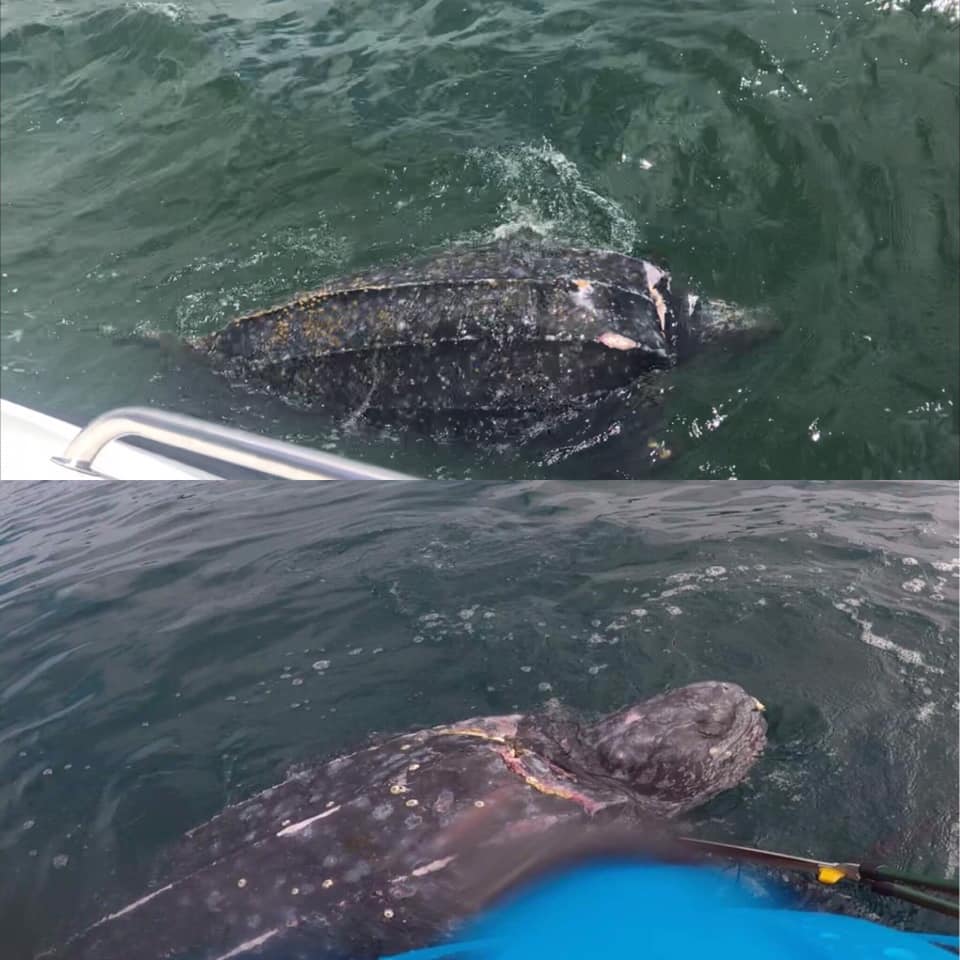
The Leatherback Turtle save by Newport SLSC members
Both of the two that died in the Palm Beach net were male, one measuring 1.99 Metres and the other 1.73 Metres.
The leatherback sea turtle (Dermochelys coriacea) is the largest of all living turtles and is the fourth-heaviest modern reptile behind three crocodilians. It is the only living species in the genus Dermochelys and family Dermochelyidae. It can easily be differentiated from other modern sea turtles by its lack of a bony shell, hence the name. Instead, its carapace is covered by skin and oily flesh. Adults average 1–1.75 m (3.3–5.7 ft) in curved carapace length (CCL), 1.83–2.2 m (6.0–7.2 ft) in total length, and 250 to 700 kg (550 to 1,540 lb) in weight. Little is known of the species' lifespan. Some reports claim "30 years or more", while others state "50 years or more". Upper estimates exceed 100 years.
Pittwater's Leatherback turtles have been dying at the hands of Europeans for a while now - although the contrast between these two reports, 130 years apart, foretells a prevalent regard for other species and nature that remains inherent in the community today:
Last Sunday a turtle weighing upwards of 600 weight was taken by some fishermen at Broken Bay with a shark hook, introduced by accident into the eye. The same evening it was brought in, and retailed at 6d. per pound. SYDNEY. (1805, December 8). The Sydney Gazette and New South Wales Advertiser (NSW : 1803 - 1842), p. 1. Retrieved from http://nla.gov.au/nla.news-article626980
AGED TURTLE
Caught in Broken Bay.
YACHTSMEN INDIGNANT.
Strong protests have been entered by residents of the Palm Beach district, yachtsmen, fishermen, and naturalists against the action of a party of fishermen in catching a big black-turtle off Lion Island, Broken Bay, this week.
The turtle, which weighed about a ton, was of a great age, and had frequented the waters of Broken Bay as far back as the memory of some of the oldest residents of the district. It was a familiar object to yachts-men and fishermen visiting the locality over many years.
A resident of Palm Beach stated last night that people living in the district had regarded the turtle as an old friend, and they were incensed when they learned that it had been caught with a rope, hauled ashore, and shot.
A veteran yachtsman said he had been visiting Broken Bay for more than 50 years, and during that period he had often seen the turtle. It was almost tame, and never did any harm. Sometimes it was mistaken for an overturned skiff. He was particularly sorry to learn that it had been caught.
The honorary secretary of the Palm Beach Surf Life-saving Club, Mr. J. G. Rohr, said he had been directed by his club to express in the strongest terms disapproval of the action of the fishing party which caught the turtle. In doing so, he though he was voicing a feeling of resentment which much be very general among those who were acquainted with the waters of Broken Bay. The old turtle was, as far as was known, the only specimen of its kind in the area, and possibly it was one of the few survivors on this section of the Australian coast. It was a familiar and welcome sight to members of the club and to yachtsmen and boating people who visited Pittwater. "So frequently had our members met with the old warrior when bringing the surf boat around Barrenjoey, that most of us felt that we were almost on speaking terms with him," he added.
The secretary of the Royal Society for the Prevention of Cruelty to Animals (Mr. S. A. Lord) said he would institute an inquiry into the matter.
Mr. T. C. Roughley, economic zoologist at the Technological Museum, said he Joined In the protest against the catching of the turtle. Its capture could serve no purpose: it seemed to him futile, and cruel. It was obvious from the weight of the turtle that it was of a great age, as the rate of growth among turtles was slow. AGED TURTLE (1936, March 14). The Sydney Morning Herald (NSW : 1842 - 1954), p. 17. Retrieved from http://nla.gov.au/nla.news-article17341700
One of the Hawksbill Turtles listed among the triggers died from being entangled in the net at Narrabeen, while North Narrabeen and Warriewood nets caught and killed a Green Turtle, Chelonia mydas, each.
Two dolphin deaths (Delphinus delphis Common Dolphin) are attributable to the shark meshing off all our beaches; one at North Steyne, and one at Narrabeen. But these are not 'threatend species'.
During the period between September 1, 2018 and April 30, 2019 (the Shark Meshing Season) the Department of Primary Industries introduced a 90 day trial of SMART Drumlines across beaches at Sydney, Newcastle and the South and North Coast.
On May 12th 2019 the DPI stated these had caught 'scores of sharks'. One of them, caught, tagged and released, was a 3.5 metre tiger shark at Newport.
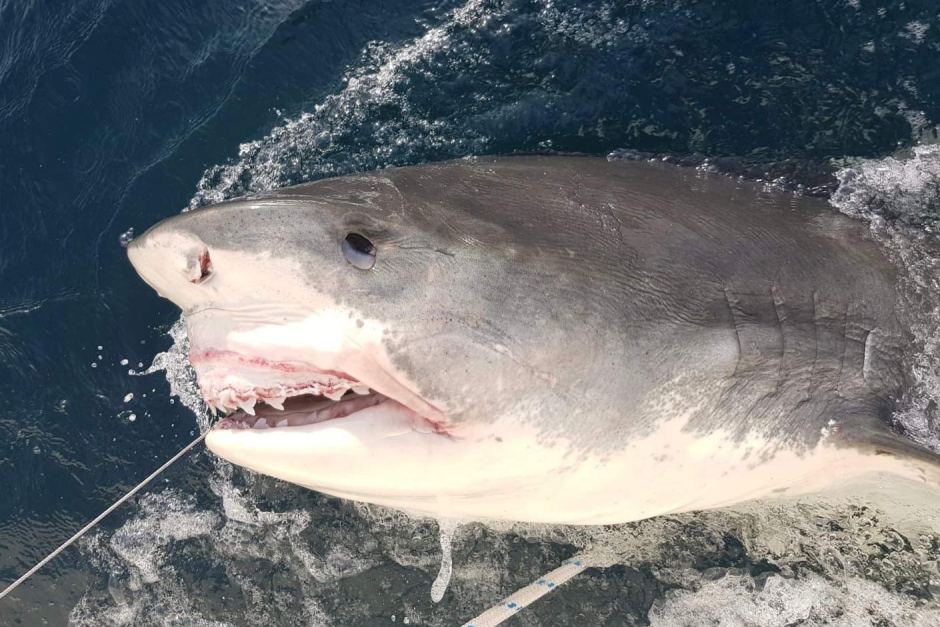
This 3.5 metre tiger shark caught in drumlines and released at Newport in May 2019. (Photo Supplied: NSW Department of Primary Industries)
Minister for Agriculture Adam Marshall said then that the SMART (Shark-Management-Alert-in-Real-Time) drumline trials helped reduce the risk of shark incidents at NSW beaches.
“We have had some great results from SMART drumlines along our NSW coastline this summer, which has helped us learn more about shark movements and the effectiveness of this technology,” Mr Marshall said.
“NSW is leading the world in trials of SMART drumlines. These innovative devices allow target sharks to be caught, tagged and released out at sea, with experts then tracking their movements and alerting authorities when a shark is near.
“In Sydney alone we managed to intercept 14 sharks over a 90 day period, while on the South Coast 16 species were caught including 6 White and 5 tiger Sharks.
“The beauty of this technology is that it not only prevents shark encounters but also allows scientists to monitor the tagged sharks and learn more about their behaviour. After the shark is tagged, they are relocated and released approximately 1km offshore. Our shark tagging program is now estimated to be the largest in the world.
“SMART drumlines complement the shark nets that are in place at Sydney, Wollongong and Newcastle beaches from 1 September to 30 April each year.” Mr. Marshall said.
The SMART Drumline trials were and are part of the NSW Government’s $16 million Shark Management Strategy.
2018-19 SMART DRUMLINE TRIALS IN OUR AREA
Location Shark species Size
Sydney (90 day trial) Catch Data to 10 May
Dee Why/Manly:
1 Tiger Shark 250cm
9 Dusky Whaler 130cm, 160cm, 140cm, 170cm,110cm, 140cm,250cm, 150cm, 150cm
Palm Beach – Newport:
1 Dusky Whaler 160cm
1 unidentified Whaler 160cm
The report also communicates that under the SMS, several studies have been initiated to investigate alternative measures to mitigate against shark bite. As the SMP is an ‘areabased’ methodology, only initiatives addressing area-protection were discussed in the Report.
Drumlines have been used in shark management strategies in Queensland and South Africa for many decades (Cliff and Dudley, 2011; Sumpton et al., 2011). Although these passively fishing baited hooks are more selective and reduce moralities of bycatch, they still impact several species particularly threatened or protected species (Sumpton et al., 2010). A new improvement to classical drumlines that incorporates a real-time ‘Catch Alert System’ using satellite communication has been invented in Reunion Island, with the aim of increasing chances of survival of catch (Perry et al., 2014; Guyomard et al., 2019). These new drumlines have been trialled in NSW and the term SMART Drumlines has now been coined (Shark Management Alert in Real Time).
To date, all three target shark species have been caught and successfully tagged and released, with extremely limited bycatch during operational deployment on the NSW far north coast (https://www.sharksmart.nsw.gov.au/technology-trials-andresearch/smart-drumlines). Survivorship has been exceptionally high as all White Sharks released have subsequently been detected through telemetry, with only one White Shark dying during capture (after entangling itself in the gear), and one White Shark washing up after apparently succumbing to post-release stress.
Following successful use of SMART Drumlines on the NSW far north coast a total of 30 SMART Drumlines (SDLs) were deployed within the SMP region between Newcastle and Manly for 3 months between February and April. During this time, two target sharks (White Sharks) were caught in the adjacent nets and none on the SDLs.
Number of non-target animals caught in the nets were similar to those caught on the SDLs (18 versus 16, respectively), although mortalities in the nets (10 versus 2) highlighted the value of SLDs in reducing impact on marine wildlife, particularly as the shark net mortalities at these trial locations included 5 protected species (2 White Sharks, 2 turtles and a dolphin).
Although trials comparing shark nets and SDLs on the far north coast highlighted the efficacy of using SDLs as a potential shark bite mitigation tool with minimal impact on marine wildlife, further trials in the SMP region are warranted as there may be latitudinal differences in species caught and their survivorship under different environmental conditions.
The use of SMART drumlines are not all the NSW DPI have been looking into. A project investigating the efficacy of sonar technology to detect and accurately assess potential shark threat (based on size of the shark) was completed by NSW DPI and the University of Technology, Sydney, during 2016-17.
The experiment provided additional useful understanding of the capabilities of the Clever Buoy (CB) system developed by Shark Mitigation Systems. The 2018/19 SMP Report states;
Overall, the experiment showed that the CB was able to detect White Sharks and the length estimates were not significantly different from the lengths independently estimated by BRUVS. Sharks were not detected further than 28m from the CB, however, this may have been due to the sonar configuration not being appropriate or calibrated for the water depth used. Almost two-thirds of CB ‘detections’ were deemed to be false positives when checked against BRUVS video. The presence of BRUVS and schools of fish appeared to influence incorrect identification of an object. It is likely that sharks travelling within 1.5m of the seabed were not detected due to being below the CB beam.
Several experiments and trials using Unmanned Aerial Vehicles (UAVs popularly known as ‘drones’) have also been conducted by NSW DPI and Southern Cross University. Preliminary results indicate that this technology may provide aerial support suitable for detection of sharks in clear waters. A review of the potential for UAVs to conduct marine fauna surveys has been published as part of this research (Colefax et al., 2017. doi:10.1093/icesjms/fsx100).
A review of these alternative, non-lethal, shark management technologies has been prepared and submitted for publication in a peer-reviewed scientific journal (McPhee et al., submitted).
Shark Meshing off our beaches and in our estuary has been a part of our landscape, or seascapes, for a long time. Every estuarine pool has netting that council has been required to maintain over generations. Residents who have lived in the area for decades have stated sharks used to be in the estuary – lots of them. People living on Scotland Island during the 1950’s, 60’s, and 70’s didn’t could see them swimming past – big ones apparently. They didn’t go in the water.
Increased activity with increased moorings and noise on the estuary, and sewage that attracts baitfish or dogs not running into the water and attracting them may have lessened the incidents of sharks in the Pittwater estuary waters but big sharks, from ‘Shark Point’ Barrenjoey down to Bayview, have been part of this ecosystem for a long time and instances of them being caught here go back a few generations too:
INNER BASIN, PITTWATER. In a letter to the Editor of the "Herald," Mr. A. C. Cooke appeals to yachtsmen to oppose the reported decision of the Kuringgai Chase trustees to close the Inner Basin, Pittwater, to all boats, irrespective of size, in order that they might convert the basin into a huge swimming pool, protected by a shark proof net. INNER BASIN, PITTWATER. (1934, November 6). The Sydney Morning Herald (NSW : 1842 - 1954), p. 10. Retrieved from http://nla.gov.au/nla.news-article17130565
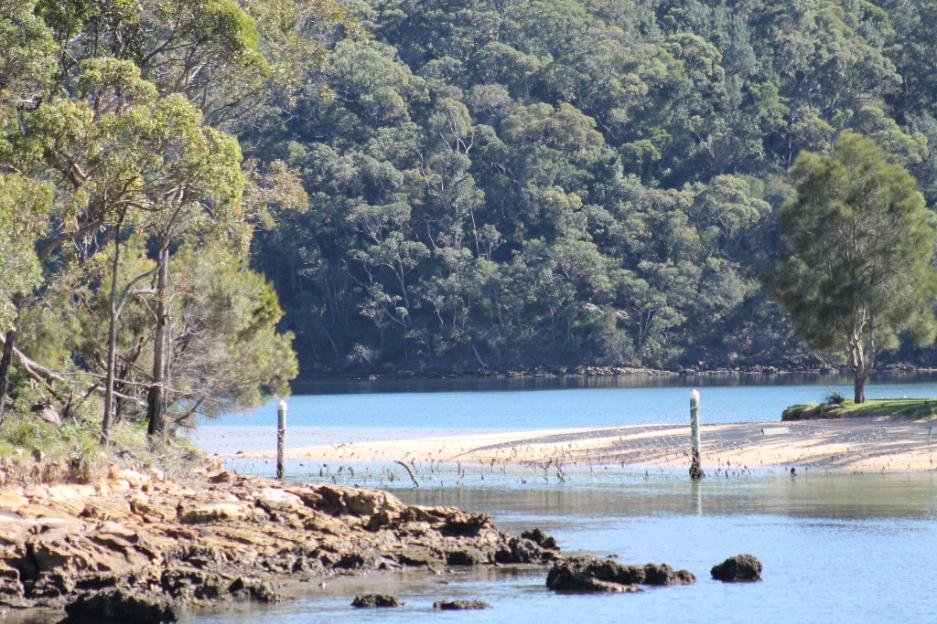
Keeping sharks put of pools
You have to swim by the calendar in some of Sydney's "sharkproof" pools.
Several sharkproof enclosures in estuaries and bays have not yet been prepared for the swimming season. In warm weather thousands of bathers use the pools. Sharks are often reported near the pools. Officials of Sydney councils which control pools said all pools would be inspected and repaired before the start of the swimming season . on October 6. Council reports on pools near Sydney are:
BALMORAL. — Enclosures will hot be put up before next week, when it will be made sharkproof. . SIRIUS COVE.— Net will be checked before the beginning of the season.
SCOTLAND ISLAND (Pittwater). — Three enclosures not yet checked. TAYLOR'S POINT, Bayview (Pittwater). — Being, repaired now.
WATSON'S BAY, RED-LEAF, PARSLEY BAY. — Being checked for the opening of the swimming season.
BEROWRA WATERS.— New netting put on pools last year,, will be checked soon. Pools which have been inspected and declared sharkproof, or recently repaired include: All Sutherland Shire Council pools, including Lillipilli, North Ewey Bay, Como, George's River Bridge and Taren Point. All Manly pools and Rockdale Council enclosures. at Sandringham, Brighton-le-Sands, Doll's Point, and Ramsgate.
And new swimming baths at Brooklyn, on the Hawkesbury River, and Paradise Beach. Pittwater. Kogarah Council pools at Sans Souci. Donnolly Park, Carss Park, and Oatley Bay. Keeping sharks put of pools (1952, September 21). The Daily Telegraph (Sydney, NSW : 1931 - 1954), p. 11. Retrieved from http://nla.gov.au/nla.news-article248655306
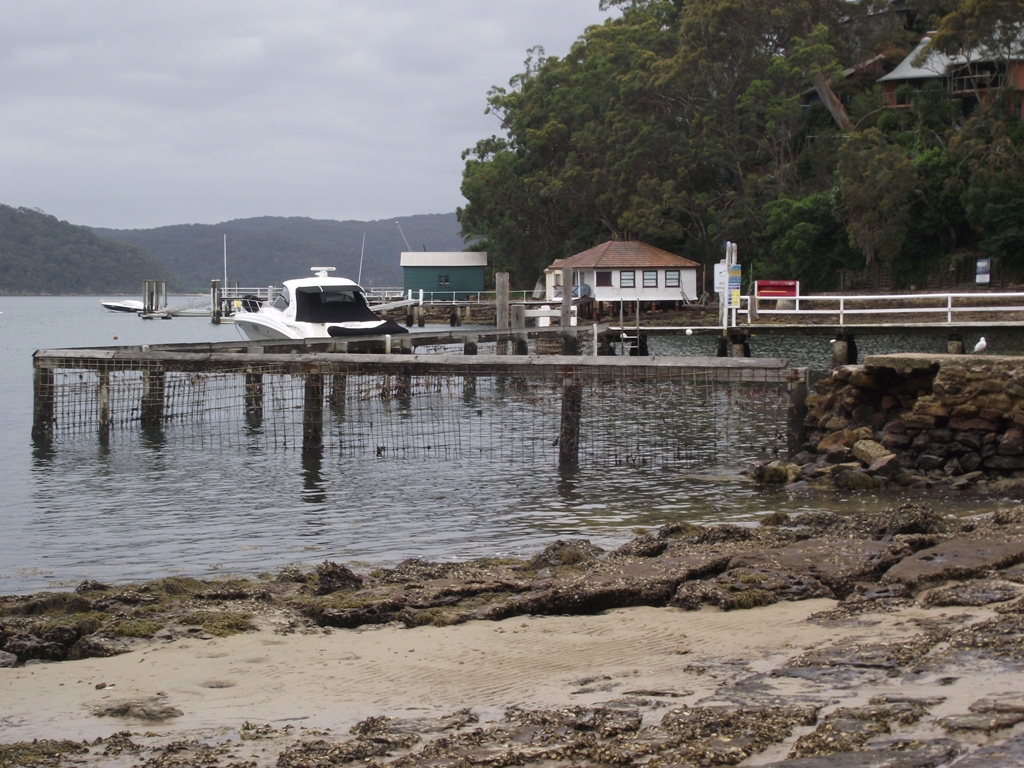
Paradise Beach pool and shark net
A Shark at Pittwater.
Mr- E. B. M'Kenny, of Ventuor, Pittwater, near Manly, writes to us as follows: I write to give you particulars of the capture of a monster shark at Pittwater on Saturday morning. The brute had been haunting the wharves and foreshores of Ventuor for some time past, and had broken several lines which had been set for him, but on Saturday morning he was safely hooked by Mr. Geo. Gates off the Ventuor Wharf. The monster pulled the boat all about the bay, and it was a merry time for over half an hour, several boats joining in the chase. Eventually the boats made fast to one another, and the shark was pulled on to the flats and killed. He proved to belong to the grey nurse species, and measured 11ft in length. A Shark at Pittwater. (1896, March 9). Evening News (Sydney, NSW : 1869 - 1931), p. 5. Retrieved from http://nla.gov.au/nla.news-article109915565
The name 'Ventuor' refers to Ventnor at Rocky Point- Elvina Bay. Sharks have also been recorded in McCarrs creek in times past:
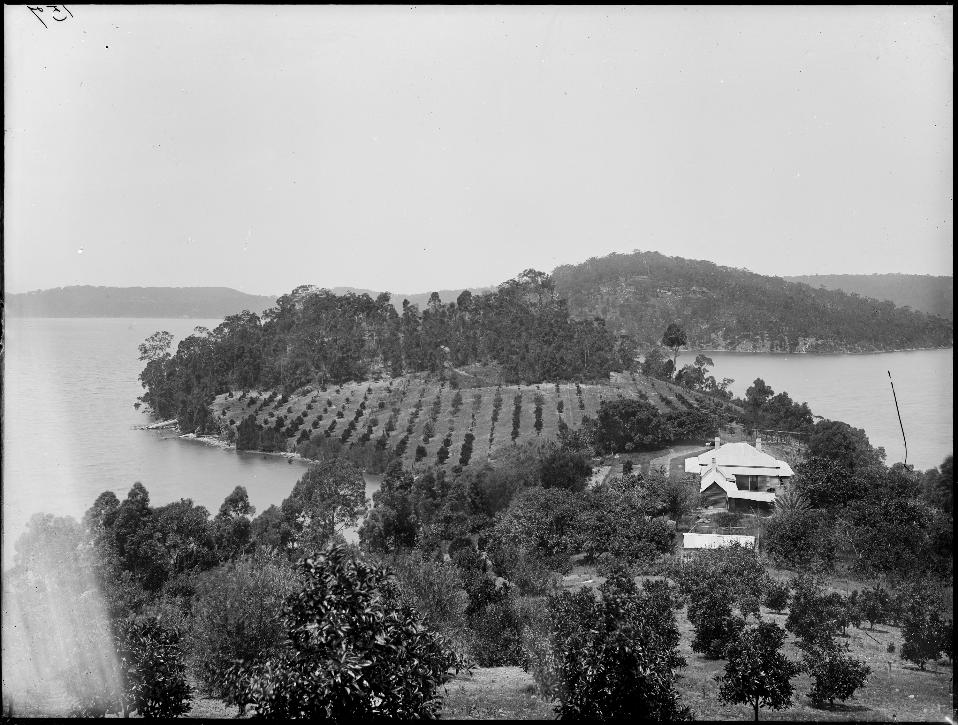
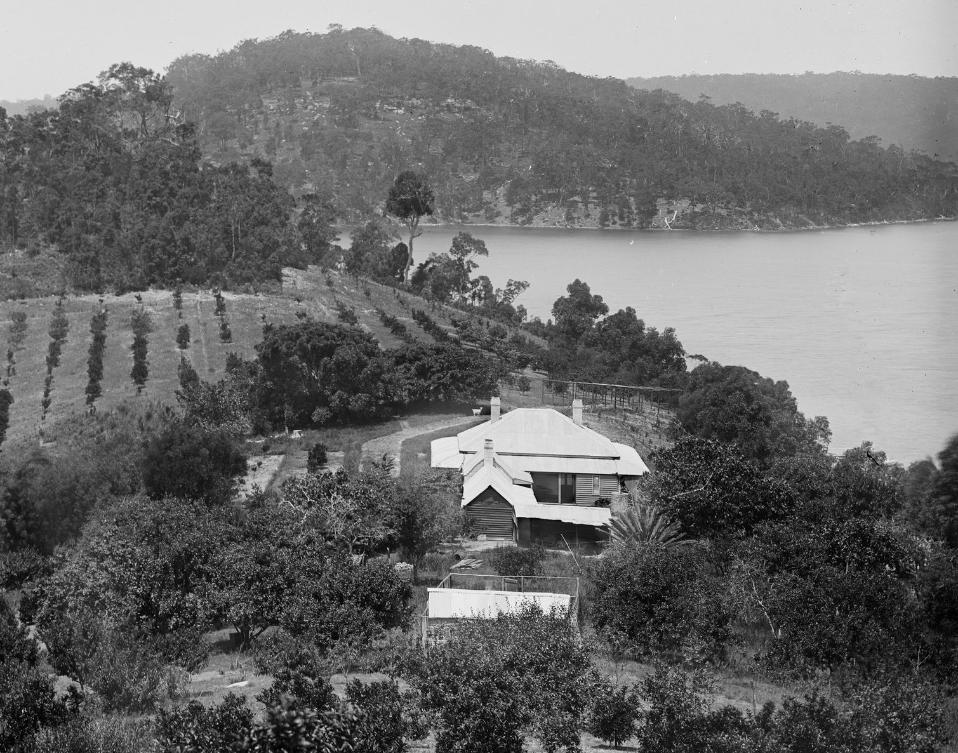
'Orange Orchard' by Charles Kerry, circa 1887-1888. From Tyrell Collection, courtesy Powerhouse Museum- the home is 'Ventnor'
This incidences attract attention, nation wide:
SHARK LEAPS FROM WATER TO SEIZE DOG
ANIMAL TAKEN FROM ROCKS 2FT. ABOVE WATER LEVEL
SURFING DANGERS.-SYDNEY, Saturday.
Sharks in Sydney are following the example of Queensland crocodiles and jumping out of the water to attack human beings. THE other day there was a case of a shark leaping from the water at The Spit to snap, at a boy standing on the jetty steps. Yesterday there was a case in which one of the monsters, estimated at 12ft. long, jumped as clear as a flying fish to take a dog standing in a rock gully 2ft. above water level.
Something like a reign of terror has started In Middle Harbour and parents are refusing to let children go out in boats for fear the monsters may make a leap over ' the gunwale. Yesterday a yachtsman coming from Barrenjoey to Middle Bay counted more than '250 enormous sharks whose fins were cutting the surface. There are great shoals of salmon on the coast just now and shark's are following them in hundreds.
TEEMING WITH SHARKS.
Fisheries expert David Stead says the harbour is simply teeming with sharks and on account of the weather conditions this is the most dangerous time of the year for surfers and swimmers in secluded places. Overcast and dull days such as have prevailed lately constitute happy hunting conditions for prowling monsters. Many prawners on the Parramatta reaches had narrow escapes, yet boys are foolhardy enough to dive off jetties straight into deep water where the monsters are known to lurk. SHARK LEAPS FROM WATER TO SEIZE DOG. (1932, January 9). The Evening News (Rockhampton, Qld. : 1924 - 1941), p. 1. Retrieved from http://nla.gov.au/nla.news-article200439430
The idea of Shark Nets being installed off Sydney beaches began where so many reported lots of sharks for years prior to this:
SHARK NETS FOR BONDI.
Special precautions are being taken at the Bondi beach. Sydney, to protect surf-bathers from sharks, in view of several recent tragedies. Experiments are being made with steel nets, buoyed by huge steel drums. ' SHARK NETS FOR BONDI. (1929, March 2). The Argus(Melbourne, Vic. : 1848 - 1956), p. 17. Retrieved from http://nla.gov.au/nla.news-article3994263
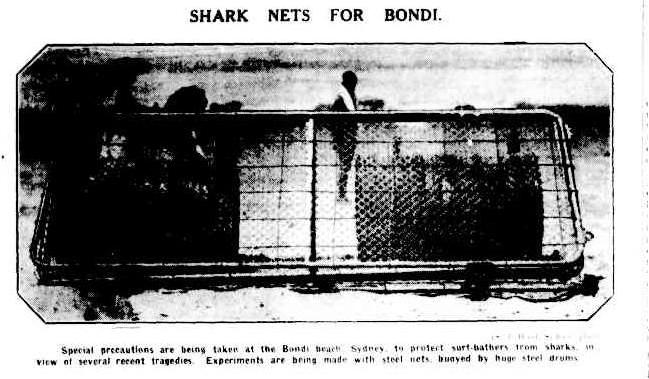
These contraptions, similar to what is used today by distance swimmers, soon became a good idea:
Swims Eight Miles: Shark-proof Nets Used. Sydney, March 8. Miss Lily Copplestone, of New Zealand, swam this afternoon from Neutral Bay to Manly, about 8 miles, in 3 hours 6 mins. 21 sec. Miss Irene Rolfe, of Bondi, also completed the swim. Her time was 4 hrs. 25 mins. Two separate shark-proof nets, towed by two launches, were used. Miss Copplestone swam strongly all the way. She will leave soon for England, where she will attempt to swim the English Channel. Swims Eight Miles: Shark-proof Nets Used. (1931, March 12).Chronicle (Adelaide, SA : 1895 - 1954), p. 43. Retrieved from http://nla.gov.au/nla.news-article90490165
Then in 1937:
SHARK-PROOF NETS Government to Consider. SYDNEY, Tuesday.
The question whether the State Government will undertake the meshing of the surf beaches as a protection against sharks is to be investigated, according to a statement made by the Minister for Local Government (Mr. Spooner),to-day. Mr. Spooner said that if the Government did undertake the meshing of the beaches it might be that private companies would purchase all the sharks caught. Certainly the Government would not be interested in establishing an industry, which was the function of private enterprise. SHARK-PROOF NETS. (1937, July 7). Northern Star (Lismore, NSW : 1876 - 1954), p. 3. Retrieved from http://nla.gov.au/nla.news-article94695001
The 2018-19 SMP Reports there were 11 interactions between swimmers and sharks in New South wales waters, two of which resulted in a serious injury and one of which occurred at a netted beach. The report records that Surf Life Saving NSW figures indicate that almost 6.9 million people visited those beaches in 2018/19, 4,679,380 of those visits being to Sydney beaches.
The 'by-catch' of having all our beaches meshed against sharks continues to be a point of contention among environmentalists and all who love all else that lives in the sea. You don't have to be a 'greenie' to want to save a turtle or a whale - and one net was reported in this annual SMPO as being damaged by a whale, again at Palm Beach.
The figures are high, and as those that were found alive and released numbers was only one hundred and fifty-seven animals (40%), and instances of these then dying from the stress anyway is recorded in other reports, many can't wait for the progression of more humane and technologically advanced methods to be employed.
The state government has confirmed this week that they will not be abandoning the Shark Meshing Program. For those fishermen and paddlers that have reported to Pittwater Online a growing number of sharks over Autumn and Winter, September 1st for the nets to go back in place will not be soon enough.
The statistics compiled on our area run below. The full report, Shark Meshing (Bather Protection) Program 2018/19 Annual Performance Report, is available to download.
From the Shark Meshing (Bather Protection) Program 2018/19 Annual Performance Report
19 October 2018, Sydney North contractor and Shark Meshing Observer report that the net at Palm Beach has suffered possible whale damage*. All net mesh and ropes were recovered
Appendix 1 – Monthly catch summaries for the 2018/19 meshing season
1 September 2018 to 28 September 2018
Beach Date Scientific Name Common Name Status Samples taken (yes/no/whole) Tagged Size (m) FL Sex
Warriewood 05/09/18 Isurus oxyrinchus Shortfin Mako Dead Yes No 2.25 F
Avalon 07/09/18 Notorynchus cepedianus Broadnose Sevengill Shark Dead Yes No 1.52 M
Palm 10/09/18 Carcharhinus brachyurus Bronze Whaler Alive & Released No Yes 2.4 M
Bilgola 11/09/18 Myliobatis australis Southern Eagle Ray Alive & Released No No 0.8 Unk.
Palm 11/09/18 Carcharhinus brachyurus Bronze Whaler Dead Yes No 2.4 M
Palm 11/09/18 Notorynchus cepedianus Broadnose Sevengill Shark Dead Yes No 1.65 M
Palm 11/09/18 Notorynchus cepedianus Broadnose Sevengill Shark Dead Yes No 1.75 M
Warriewood 14/09/18 Chelonia mydas Green Turtle Dead and decomposed No No 0.43 Unk.
Warriewood 17/09/18 Myliobatis australis Southern Eagle Ray Alive & Released No No 0.65 F
Dee Why 04/09/18 Isurus oxyrinchus Shortfin Mako Dead Yes No 2.2 M
Curl Curl 17/09/18 Isurus oxyrinchus Shortfin Mako Dead Yes No 1.43 M
Detailed Catch Report - 29 September 2018 to 26 October 2018
Bilgola 30/09/18 Myliobatis australis Southern Eagle Ray Alive & Released No No 1.2 Unk.
Palm 03/10/18 Aetobatus ocellatus White Spotted Eagle Ray Dead Whole No 1.4 F
Bilgola 09/10/18 Myliobatis australis Southern Eagle Ray Alive & Released No No 0.7 Unk.
Warriewood 13/10/18 Carcharias taurus Greynurse Shark Alive & Released No No 2.2 M
Bilgola 19/10/18 Carcharodon carcharias White Shark Alive & Released No Yes 2.4 F
Dee Why 16/10/18 Mobula japanica Spinetail Devil Ray Dead Whole No 2.5 M
Curl Curl 26/10/18 Isurus oxyrinchus Shortfin Mako Dead Yes No 1 M
Detailed Catch Report - 27 October 2018 to 23 November 2018
Curl Curl 02/11/18 Sphyrna zygaena Smooth Hammerhead Dead Yes No 1.55 F
Manly 16/11/18 Sphyrna zygaena Smooth Hammerhead Dead Yes No 1.46 F
Detailed Catch Report - 24 November 2018 to 21 December2018
Warriewood 03/12/18 Myliobatis australis Southern Eagle Ray Dead Whole No 0.97 F
Warriewood 08/12/18 Myliobatis australis Southern Eagle Ray Alive & Released No No 0.9 F
Palm 11/12/18 Sphyrna zygaena Smooth Hammerhead Dead Yes No 1.23 F
Whale 17/12/18 Myliobatis australis Southern Eagle Ray Dead Whole No 1.2 F
Palm 19/12/18 Sphyrna zygaena Smooth Hammerhead Dead Yes No 1.1 F
Avalon 19/12/18 Myliobatis australis Southern Eagle Ray Alive & Released No No 0.6 F
Avalon 19/12/18 Myliobatis australis Southern Eagle Ray Alive & Released No No 0.6 F
Detailed Catch Report - 22 December 2018 to 18 January 2019
Bilgola 27/12/18 Myliobatis australis Southern Eagle Ray Alive & Released No No 1 M
Warriewood 27/12/18 Myliobatis australis Southern Eagle Ray Alive & Released No No 0.6 M
Newport 03/01/19 Myliobatis australis Southern Eagle Ray Alive & Released No No 0.7 M
Bilgola 04/01/19 Myliobatis australis Southern Eagle Ray Alive & Released No No 0.7 M
Sydney Central
North Steyne 31/12/18 Delphinus delphis Common Dolphin Dead Yes No 2 Unk.
Narrabeen 04/01/19 Eretmochelys imbricata Hawksbill Turtle Dead Whole No 0.5 Unk.
North Narrabeen 07/01/19 Chelonia mydas Green Turtle Dead Whole No 0.55 Unk.
Queenscliff 16/01/19 Myliobatis australis Southern Eagle Ray Alive & Released No No 1 F
Detailed Catch Report - 19 January 2019 to 15 February 2019
Mona Vale 29/01/19 Sphyrna zygaena Smooth Hammerhead Dead Yes No 1.35 M
Palm 31/01/19 Sphyrna zygaena Smooth Hammerhead Dead Yes No 1.1 M
Palm 03/02/19 Dermochelys coriacea Leatherback Turtle Dead No No 1.99 M
Palm 08/02/19 Dermochelys coriacea Leatherback Turtle Dead No No 1.73 M
Narrabeen 26/01/19 Delphinus delphis Common Dolphin Dead Whole No 1.05 Unk.
Queenscliff 03/02/19 Sphyrna zygaena Smooth Hammerhead Dead Yes No 1.49 F
Detailed Catch Report – 16 February 2019 to 15 March 2019
Mona Vale 01/03/19 Rhinoptera neglecta Australian Cownose Ray Dead Yes No 0.6 F
Mona Vale 04/03/19 Carcharhinus leucas Bull Shark Dead Whole No 1.8 M
Bilgola 07/03/19 Carcharhinus limbatus Common Blacktip Dead Yes No 2.12 F
Newport 10/03/19 Dermochelys coriacea Leatherback Turtle Alive & Released No No 1.2 Unk.
Sydney Central Harbord 06/03/19 Rhinoptera neglecta Australian Cownose Ray Alive & Released No No 0.7 F
Narrabeen 11/03/19 Squatina albipunctata Eastern Angel Shark Alive & Released No No 1.12 F
Detailed Catch Report – 16 March 2019 to 12 April 2019: Nothing!
Table 9: Detailed Catch Report – 13 April 2019 to 30 April 2019
Newport 30/04/19 Rhinoptera neglecta Australian Cownose Ray Alive & Released No No 1 M
Palm 30/04/19 Sphyrna zygaena Smooth Hammerhead Dead Yes No 0.9 F
Sydney Central North Narrabeen 28/04/19 Sphyrna zygaena Smooth Hammerhead Dead Yes No 1.01 F
A Few Extras
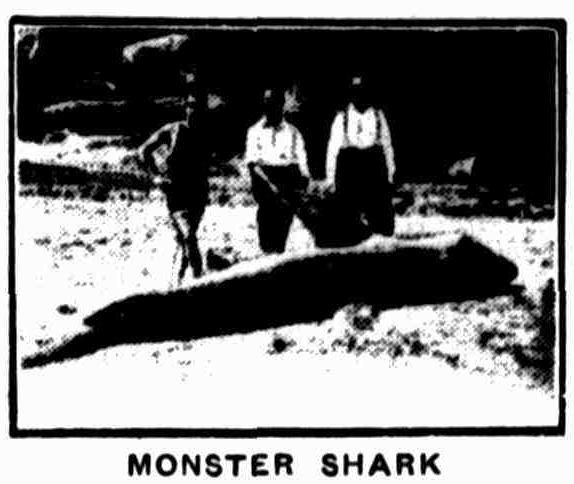
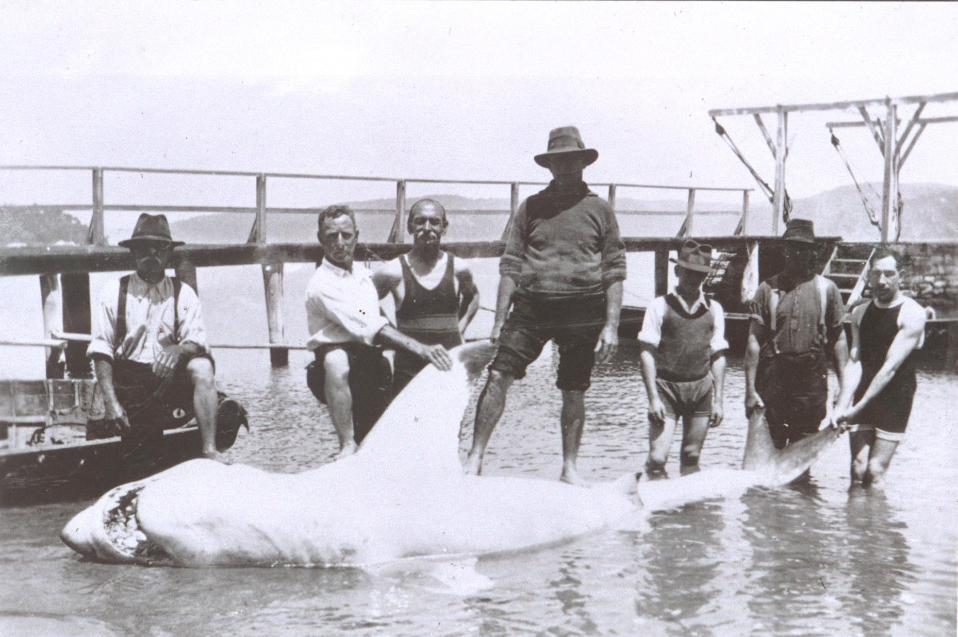
Launch Holed By Big Shark
SYDNEY: Attacked by a 16ft. shark, four men fought to stop their open launch sinking a mile off Barrenjoey Lighthouse, Palm Beach, yesterday. Robert Newton, Stan Prosser, Dan Blunt and Bill Linnert, all of Bondi Junction, were fishing. The boat was tilted before the shark struck and, after straightening up, they found the hole was just above the waterline. 'We used towels, shirts and everything we could lay our hands on to stop the boat filling,' said Newton. Launch Holed By Big Shark (1947, February 24). The Newcastle Sun(NSW : 1918 - 1954), p. 2. Retrieved from http://nla.gov.au/nla.news-article158248882